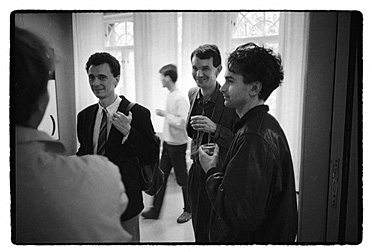
PHOTOGRAPHY 87 TAMPERE
The Tampere-born Metamorphosis of Documentary Photography
In June 1987 three photographers from Great Britain arrived in Tampere: Martin Parr, Paul Graham and Victor Burgin. New British photography filled the then Museum of Modern Art of Tampere with large photos that shone with colour and a critical attitude towards traditional documentary.
Victor Burgin, who was known as a photographer and a theoretician, surprised the audience of the opening lecture of the first international photographic event Photography 87 Tampere, by his conceptual and poster-like Office at Night -pictures and by his psychoanalysis-coloured pondering on the fundamental passion of photography: voyeurism. Merja Salo crystallised Burgin's thoughts in an interview in Valokuva (Finnish Photography) - magazine: "That which is not photographed is equally interesting as that which is photographed" (Salo, 1987).

Barely had photographers used to black-and-white documentary photography recovered from Burgin's deeply materialistic theory, which stripped photography of all aestheticism and mysticism (Burgin 1982), when Martin Parr and Paul Graham shook awake the photographers who took part in their workshop by disassociating themselves from classical humanistic-reformative documentary photography and photojournalism. Parr presented his colour prints of New Brighton and Graham of labour exchanges at the Museum of Modern Art.
New British photography arrived at Tampere as by stealth. The photographer Petri Nuutinen visited English photographic galleries in 1986. He met Parr and Graham during his journey and invited them to Tampere. Nuutinen assembled a theme issue of British photography; Valokuva-magazine described Parr and Graham as epochal, but also knowledgeable about the rich tradition in documentary photography (Nuutinen, 1986).
In the ironic pictures of Martin Parr's 1986 book The Last Resort families spend their holidays in New Brighton. Nobody seems to care about the fact that the average Brits were sunbathing and the children were playing on the beach amidst trash. The confused adults lighted by Parr's supplementary flash are immersed in their thoughts and seen as unreal as mannequins. The decline and attraction of traditional holiday resorts are embodied in the fish and chips - fast food culture at the swimming pool of Lido and the game arcades of New Brighton.
Paul Graham's photography book Beyond Caring (1986) is deeply rooted in the traditional theme of revealing wrongs when depicting British labour exchanges and social offices. On the other hand, his Troubled Land-documentary the political tension and conflicts of Northern Ireland are discreetly shown in the graffiti painted on streets and signs. The social landscape of Graham conveys political and symbolic messages. They are signals that the viewers have to find themselves.